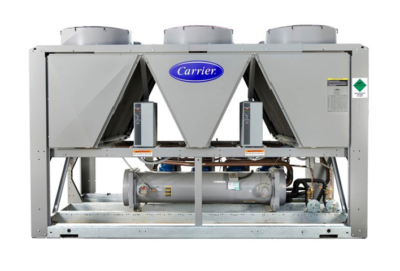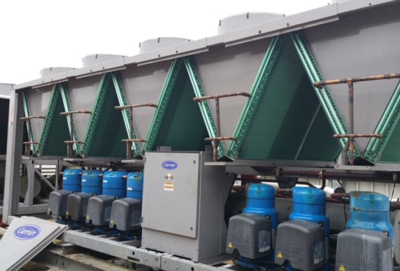Revamping the Microchannel Coil in Carrier® AquaSnap® Chillers: Enhance Performance and Reliability
Address the inherent leakage problems in Carrier’s AquaSnap chiller and similar OEM microchannel heat exchanger (MCHX) coils with a cost-effective microchannel conversion.
When it comes to replacing commercial condenser coils, the Carrier AquaSnap chiller is a frequent contender. Alongside building a replacement coil for this popular unit, many consider converting its all-aluminum microchannel design to a copper-tube, aluminum-fin coil setup.
Microchannel coils have been a staple in the air conditioning industry for over a decade, not just in Carrier units but across most original equipment manufacturer (OEM) equipment. The use of aluminum helps reduce costs and cut down on refrigerant usage. However, these advantages come with notable downsides.

A Carrier AquaSnap chiller featuring all-aluminum microchannel coils.
The Drawbacks of Microchannel Coils
Microchannel coils can accumulate dirt similarly to the lint filter in your dryer. Without regular maintenance, the high head pressure of the system can lead to operational issues. Moreover, precise refrigerant charging is crucial for proper operation due to the low refrigerant volume in MCHX coils. Repairing an all-aluminum coil is also challenging, often requiring two-part epoxy or a torch, and aluminum becomes vulnerable to environmental conditions during repairs. Additionally, leaks frequently occur at the copper-to-aluminum connections.
#ChangeTheChannel: Upgrading to Copper-Tube, Aluminum-Fin Coils
Switching to high-grade copper-tube, aluminum-fin coils—a microchannel conversion—can significantly enhance the performance and reliability of your Carrier AquaSnap chiller while extending its lifespan.
Key benefits include:
- Increased durability
- Easier to repair and maintain compared to microchannel coils
- Ability to pump down the system. Microchannel coils feature flat plates with tiny holes, which limit refrigerant capacity by up to 30%. In contrast, copper-tube coils allow compressors to pump refrigerant into the condenser coils during repairs, eliminating the need to recover refrigerant from the entire system before making adjustments. This saves both time and money.
- Long-term cost efficiency by minimizing repairs and reducing refrigerant losses due to leaks

A Carrier AquaSnap chiller equipped with copper-tube, aluminum-fin coils.
Completing the Circuit
When swapping out microchannel condenser coils for copper-tube condenser coils, it’s essential to complete the circuit. For example, if a unit has eight microchannel coils with four per circuit and only one coil is faulty, all four coils in that circuit must be replaced. This is because copper-tube coils require more refrigerant per circuit, and pairing them with microchannel coils could cause operational issues due to differing refrigerant pressure drops.
#MastersOfMicrochannelConversion
While the Carrier AquaSnap chiller is among the more common units needing microchannel conversions, this upgrade is applicable to virtually any major brand or model of commercial HVAC system. Over the years, we’ve successfully converted thousands of microchannels, establishing Nationwide Coils as the go-to experts in microchannel conversions. If you're considering this advantageous upgrade, reach out to our team. Call 1.888.CoilPro or email us anytime. All we need is the unit's make and model number to begin the process.
In addition to improving performance and reliability, switching to copper-tube, aluminum-fin coils ensures long-term savings and peace of mind. Don’t let the drawbacks of microchannel coils compromise your system. Contact us today and take the first step toward enhanced efficiency and longevity.
Acrylic Kukui Necklace,Artificial Kukui Neck Lei,Artifical Kukui Jewellery,Natural Kukui Jewellery Set
Xuzhou Kylin Craft & Gifts Co., Ltd. , https://www.kylincraftandgifts.com
